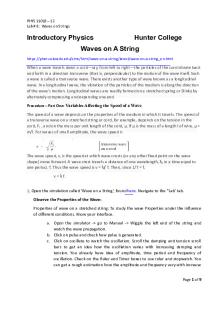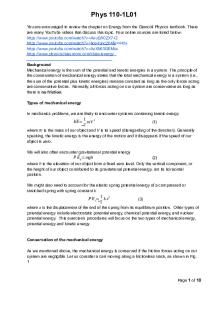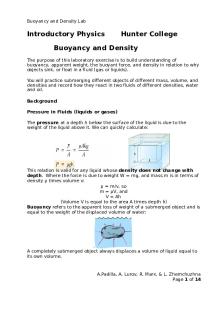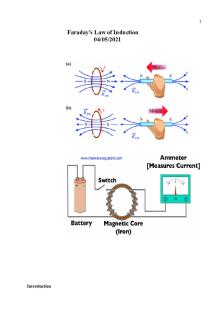LAB 3 PHYS 1429 PDF

| Title | LAB 3 PHYS 1429 |
|---|---|
| Author | Noor Drissi |
| Course | General Physics I Workshop |
| Institution | University of Virginia |
| Pages | 3 |
| File Size | 143.9 KB |
| File Type | |
| Total Downloads | 71 |
| Total Views | 162 |
Summary
PHYS 1429 LAB 3 ESSAY...
Description
PHYS 1429 February 5, 2019 Overview: In this lab, students explored how a slower predator could catch a faster prey using one dimensional kinematics. To model this problem, students dropped two carts down a frictionless track. One cart modeled a gazelle, which had a fan on top of it in order to lower its acceleration, and the other cart modeled the lion. The gazelle had a distance head start on the lion so it was dropped at different distances farther down the track than the lion. The data was recorded on the capstone software with a motion sensor set to narrow beam and a smart cart. The independent variable of this experiment was the distance head start of the gazelle while the dependent variable was the time it took for the lion to catch the gazelle. Acceleration is the change in velocity over time, so students had to explore if the lion’s faster acceleration would allow it to catch the gazelle. Predictions: Qualitative: Since the lion has a greater acceleration than the gazelle but the gazelle has a higher maximum velocity, it was predicted the lion could only catch the gazelle if it began chasing at a close enough distance. This is because the lion would have to intercept the gazelle while it is still accelerating. If the gazelle reaches its top speed before the lion catches it, the lion will never catch up to the gazelle. Quantitative: Equation 1: t=√(2x0G/(aL-aG)) (see appendix A) The relationship between the time t, the lions acceleration aL, the gazelle’s acceleration aG, and the head start of the gazelle x0G, is shown in Equation 1. This can be used to predict the time at which the lion intercepts the gazelle if their accelerations and the head start of the gazelle is known. Using this information it was predicted that the shorter the head start of the gazelle, the quicker the lion will intercept the gazelle, if at all. Procedure, Results, and Data Analysis: To gather data in this experiment, students used the capstone software, a motion sensor to measure the acceleration of the cart depicting the lion, and a smart cart to measure the acceleration of the gazelle. Students conducted 5 different trials, each varying the initial distance of the gazelle in order to see how much time it took for the lion to catch the gazelle with both carts starting from rest by graphing velocity vs time. Acceleration was measure by taking the slope of the velocity vs. time graphs. The average acceleration of the lion was .654+-.019 m/s2 while the average acceleration of the gazelle was .308+-.008m/s2 (see Appendix B). Using Equation 1, the theoretical time it should have taken for the lion cart to catch the gazelle cart was calculated (see Appendix B). The theoretical time was in agreement with the data from lab when the gazelle had a .4 and a .5 meter head start. However, for the other distances, the data was not in agreement by two error bars. Conclusion: The data found agreed with the prediction that a slower predator could catch a faster prey if it has a greater acceleration. It also supports the prediction that there is a distance head start where it would be futile for the lion to chase after the gazelle. This experiment was not able to represent a lion chasing a gazelle very accurately as the one-dimensional kinematics used in the calculations do not account for the terrain in which a real world situation would take place. While an analysis of the one dimensional kinematics involved in this situation explain how a lion can catch a gazelle and how a gazelle can avoid capture, many other factors in the real world could benefit the lion in its chase, such as the presence of other predators in the area, and the onset of fatigue in the gazelle. However, based solely on the calculations in the experiment, the lion should not continue to chase the gazelle if it does not catch it before it reaches its top speed. In order to improve the experiment and reduce error the experiment should have been conducted with equipment to release the carts as opposed to the experimenters, as a human releasing the cart can possibly affect the initial velocity of both carts.
Appendix A: Equation for time it takes the lion to catch the gazelle
Appendix B: Data
Time it took for lion cart to catch the gazelle Distance (cm)
Time (s)
20
0.9
30
1.20
40
1.50
50
1.60
60
1.65
Acceleration of the lion and gazelle cart Trial
Acceleration of Gazelle (m/s2)
Acceleration of Lion (m/s2)
1
.296
.667
2
.317
.692
3
.330
.647
4
.284
.681
5
.313
.582
Average
.308+-.008
.654+-.019
Theoretical time it should have take lion cart to catch gazelle cart Distance (m)
Theoretical Time (s)
.2
1.08+-.06
.3
1.32+-.08
.4
1.52+- .09
.5
1.70+-.10
.6
1.86+-.11...
Similar Free PDFs

LAB 3 PHYS 1429
- 3 Pages

PHYS Lab Report 3
- 7 Pages

Phys 208 Lab Report # 3
- 3 Pages

Phys lab 4 - Lab report
- 10 Pages

Phys lab report 2
- 14 Pages

Phys lab 8 - Lab report
- 9 Pages

Phys lab 5 - Lab report
- 10 Pages

Phys lab 10 - Lab report
- 14 Pages

Lab 201 Phys 2 Lab - Lab
- 4 Pages

Lecture 3 Phys 2130
- 6 Pages

PHYS 1 Assignment 3
- 6 Pages

LAB Report #4 phys 224
- 5 Pages

PHYS 215 Vectors - Lab Report
- 2 Pages

Phys lab 6 - Lab report 6
- 13 Pages

Lab report 4 int phys
- 4 Pages

PHYS 1000 - Unit 3 Notes
- 7 Pages
Popular Institutions
- Tinajero National High School - Annex
- Politeknik Caltex Riau
- Yokohama City University
- SGT University
- University of Al-Qadisiyah
- Divine Word College of Vigan
- Techniek College Rotterdam
- Universidade de Santiago
- Universiti Teknologi MARA Cawangan Johor Kampus Pasir Gudang
- Poltekkes Kemenkes Yogyakarta
- Baguio City National High School
- Colegio san marcos
- preparatoria uno
- Centro de Bachillerato Tecnológico Industrial y de Servicios No. 107
- Dalian Maritime University
- Quang Trung Secondary School
- Colegio Tecnológico en Informática
- Corporación Regional de Educación Superior
- Grupo CEDVA
- Dar Al Uloom University
- Centro de Estudios Preuniversitarios de la Universidad Nacional de Ingeniería
- 上智大学
- Aakash International School, Nuna Majara
- San Felipe Neri Catholic School
- Kang Chiao International School - New Taipei City
- Misamis Occidental National High School
- Institución Educativa Escuela Normal Juan Ladrilleros
- Kolehiyo ng Pantukan
- Batanes State College
- Instituto Continental
- Sekolah Menengah Kejuruan Kesehatan Kaltara (Tarakan)
- Colegio de La Inmaculada Concepcion - Cebu